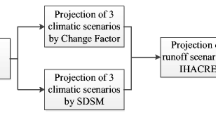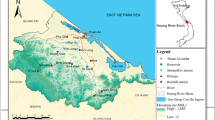Abstract
This study intended to estimate the spatial and temporal variation of current and projected water demand and water availability under climate change scenarios in Weyib River basin, Bale mountainous area of Southeastern Ethiopia. Future downscaled climate variables from three Earth System Models under the three RCP emission scenarios were inputted into ArcSWAT hydrological model to simulate different components of water resources of a basin whereas current and projected human and livestock population of the basin is considered to estimate the total annual water demand for various purposes. Results revealed that the current total annual water demand of the basin is found to be about 289 Mm3, and this has to increase by 83.47% after 15 years, 200.67% after 45 years, and 328.78% after 75 years by the 2020s, 2050s, and 2080s, respectively, from base period water demand mainly due to very rapid increasing population (40.81, 130.80, and 229.12% by the 2020s, 2050s, and 2080s, respectively) and climatic variability. The future average annual total water availability in the basin is observed to be increased by ranging from 15.04 to 21.61, 20.08 to 23.34, and 16.21 to 39.53% by the 2020s, 2050s, and 2080s time slice, respectively, from base period available water resources (2333.39 Mm3). The current water availability per capita per year of the basin is about 3112.23 m3 and tends to decline ranging from 11.78 to 17.49, 46.02 to 47.45, and 57.18 to 64.34% by the 2020s, 2050s, and 2080s, respectively, from base period per capita per year water availability. This indicated that there might be possibility to fall the basin under water stress condition in the long term.



Similar content being viewed by others
References
Brekke LD, Dettinger MD, Maurer EP, Anderson M (2008) Significance of model credibility in estimating climate projection distributions for regional hydroclimatological risk assessments. Clim Chang 89:371–394. doi:10.1007/s10584-007-9388-3
Faramarzi M, Abbaspour KC, Ashraf Vaghefi S et al (2013) Modeling impacts of climate change on freshwater availability in Africa. J Hydrol 480:85–101. doi:10.1016/j.jhydrol.2012.12.016
Faruqui N. I, Biswas, A. K., and Bino, M. J. (2001) Water management in Islam, United Nations University
Federal Democratic Republic of Ethiopia Ministry of Water Resources, Genale-Dawa River Basin Integrated Resources Development Master Plan Study Final Report, Vol., II.3.H.Irrigation and Drainage_ Final Report, July 2007a
Federal Democratic Republic of Ethiopia Ministry of Water Resources, Genale-Dawa River Basin Integrated Resources Development Master Plan Study Final Report, Vol. II.5.P. Social and Institutional Structures, July 2007b
Federal Democratic Republic of Ethiopia Ministry of Water Resources, Genale-Dawa River Basin Integrated Resources Development Master Plan Study Final Report, Vol. II.3.1.Water Supply and Sanitation _ Final Report, July 2007c
Gleick PH (1996) Basic water requirements for human activities: meeting basic needs. Water Int 21:83–92. doi:10.1080/02508069608686494
Hutson BSS, Schwarz BGE (1996) Estimates of future water demand for selected water-service areas in the upper Duck River basin, Central Tennessee with a section on methodology used to develop population forecasts for Bedford, Marshall, and Maury counties, Tennessee, from 1993 thro
IPCC (2007) Climate change 2007 : impacts, adaptation and vulnerability : Working Group II contribution to the Fourth Assessment Report of the IPCC Intergovernmental Panel on Climate Change. Work Gr II Contrib to Intergov Panel Clim Chang Fourth Assess Rep 1:976. doi:10.2134/jeq2008.0015br
Latha J, Saravanan S, Palanichamy K (2010) A semi-distributed water balance model for Amaravathi River basin using remote sensing and GIS. Int J Geomatics Geosci 1:252–263
Lehner B, Czisch G, Vassolo S (2005) The impact of global change on the hydropower potential of Europe: a model-based analysis. Energy Policy 33(7):839–855
Maurer EP, Hidalgo HG, Maurer EP, Utility HGH (2008) Utility of daily vs. monthly large-scale climate data: an intercomparison of two statistical downscaling methods to cite this version: Utility of daily vs. monthly large-scale climate data: an intercomparison of two statistical downscaling methods. 551–563
Monteith, J.L., (1965) Evaporation and the environment in the state and movement of water in living organisms, XIXth symposium. Soc. For Exp. Biol., Swansea, Cambridge University Press. pp. 205–234
Oki T, Kanae S (2006) Global Hydrological Cycles and World Water Resources. Science 313(80):1068–1072. doi:10.1126/science.1128845
Reichler T, Kim J (2008) How well do coupled models simulate today’s climate? Bull Am Meteorol Soc 89:303–311. doi:10.1175/BAMS-89-3-303
Roy, S. B., Chen, L., Girvetz, E., Maurer, E. P., Mills, W. B., & Grieb, T. M. (2010). Evaluating sustainability of projected water demands under future climate change scenarios New York: Natural Resources Defence Council
Serur AB, Sarma AK (2016a) Evaluation of the ArcSWAT model in simulating catchment Hydrology: in Weyib River basin, bale mountainous area of Southeastern Ethiopia. Int. J. Innov Emerg Res Eng 3:3–11
Shiklomanov IA, Rodda JC (2003) World water resources at the beginning of the twenty-first century. Cambridge Univ Press 452
United Nations (2004) World population to 2300. N Y 18:553–561. doi: 10.1016/j.asieco.2007.02.015
USDA-SCS (United States Department of Agriculture-Soil Conservation Service), (1972) National Engineering Handbook Section 4 Hydrology, Chapters 4–10
Vaughn J (2007) Conflicts over natural resources: a reference handbook. ABC-CLIO Inc, England
Vorosmarty CJ (2000) Global water resources: vulnerability from climate change and population growth. Science 289(80):284–288. doi:10.1126/science.289.5477.284
Wang L (2005) Cooperative Water Resources Allocation among Competing Users: PhD Thesis, University of Waterloo, Waterloo, Ontario, Canada
Acknowledgements
This research did not receive any specific grant from funding agencies in the public, commercial, or not-for-profit sectors. The authors express their heartfelt gratitude to the Ministry of Water and Energy (MoWE), Ethiopia, for providing us the meteorological, hydrological, and spatial data to be considered for this study as well as the office provide us some technical report documents that helped to extract all the required information while we are estimating the water demands for various purposes. The authors also would like to express their gratitude to the anonymous reviewers, the section editor, the associate editor, and the editor for their excellent suggestions, which will strengthen the paper.
Author information
Authors and Affiliations
Corresponding author
Rights and permissions
About this article
Cite this article
Serur, A.B., Sarma, A.K. Current and projected water demand and water availability estimates under climate change scenarios in the Weyib River basin in Bale mountainous area of Southeastern Ethiopia. Theor Appl Climatol 133, 727–735 (2018). https://doi.org/10.1007/s00704-017-2219-1
Received:
Accepted:
Published:
Issue Date:
DOI: https://doi.org/10.1007/s00704-017-2219-1




